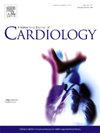在一项基于人群的研究中,肥胖和缺乏运动是心力衰竭发生的最强危险因素。
IF 3.2
2区 医学
Q2 CARDIAC & CARDIOVASCULAR SYSTEMS
引用次数: 0
摘要
背景:合并症与发生心力衰竭(HF)的风险增加有关。然而,合并症通常聚集在一起,并且缺乏关于多病集群与保留(HFpEF)和降低射血分数(HFrEF)的HF事件之间关系的数据。方法:我们在前瞻性观察性肾脏和血管终末期疾病预防(PREVEND)队列研究中确定了6839名参与者的多发病模式,并使用潜在分类分析研究了它们与新发心衰的关系。结果:参与者基线时的平均年龄为53.8 岁,其中50% 为女性。我们确定了六个多病集群:1)年轻[N = 2118,最小的年龄和最低数量的慢性疾病),2)老年[N = 1198,古老的时代,盛行的慢性肾脏疾病和高胆固醇血症),3)肺病(N = 578,盛行的呼吸问题),4)身心[N = 527,肌痛性脑脊髓炎患病率高,焦虑和压力),5)心理[N = 1815年盛行的抑郁和6)肥胖/缺乏身体活动[N = 603年盛行的肥胖,高血压,心肌梗塞和中风]。在110,621人年的随访中,622名参与者发生心力衰竭,其中390名患有HFrEF, 220名患有HFpEF。在对潜在混杂因素进行校正后,老年人(校正风险比(aHR) 2.46, 95 %可信区间(CI) 1.89-3.20)、肺部疾病(aHR 2.10, 95 % CI 1.51-2.92)和肥胖/缺乏运动(aHR 3.80, 95 % CI 2.86-5.06)组发生HF的风险高于年轻组,年轻组的风险最低。在所有群集中,与HFpEF相比,患者更容易发生HFrEF。然而,肥胖/缺乏运动的人群相对更容易发生HFpEF而不是HFrEF。结论:合并症自然聚集在6个不同的多病群中,每个群对参与者HF风险的影响不同。这些数据强调了将多重发病作为心衰危险因素的重要性。本文章由计算机程序翻译,如有差异,请以英文原文为准。

Obesity and inactivity cluster the strongest risk factor for the development of heart failure in a population-based study
Background
Comorbidities are associated with an increased risk of incident heart failure (HF). However, comorbidities usually cluster together and data on the association between multimorbidity clusters and incident HF with preserved (HFpEF) and reduced ejection fraction (HFrEF) are lacking.
Methods
We identified multimorbidity patterns in 6839 participants from the prospective observational Prevention of Renal and Vascular End-stage Disease (PREVEND) cohort study using latent class analysis and investigated their association with new-onset HF.
Results
The participants' mean age at baseline was 53.8 years, and 50 % were women. We identified six multimorbidity clusters: 1) young [N = 2118, youngest age and lowest number of chronic conditions], 2) elderly [N = 1198, oldest age, high prevalence of chronic kidney disease and hypercholesterolemia], 3) pulmonary disease [N = 578, high prevalence of respiratory problems], 4) psychosomatic [N = 527, high prevalence of myalgic encephalomyelitis, anxiety and stress], 5) psychological [N = 1815, high prevalence of depression] and 6) obese/physical inactivity [N = 603, high prevalence of obesity, hypertension, myocardial infarction and stroke]. During 110,621 person-years of follow-up 622 participants developed heart failure of which 390 with HFrEF and 220 with HFpEF. After adjusting for potential confounders, the elderly (adjusted hazard ratio (aHR) 2.46, 95 % confidence interval (CI) 1.89–3.20), pulmonary disease (aHR 2.10, 95 % CI 1.51–2.92), and obese/physical inactivity (aHR 3.80, 95 % CI 2.86–5.06) clusters had a higher risk of HF compared with the young cluster, which had the lowest risk. Among all clusters, patients were more likely to develop HFrEF compared to HFpEF. However, the obese/physical inactivity cluster was relatively more likely to develop HFpEF than HFrEF.
Conclusions
Comorbidities naturally clustered in six distinct multimorbidity clusters, each impacting participants' HF risk differently. These data emphasize the importance of addressing multimorbidity as a risk factor for HF.
求助全文
通过发布文献求助,成功后即可免费获取论文全文。
去求助
来源期刊

International journal of cardiology
医学-心血管系统
CiteScore
6.80
自引率
5.70%
发文量
758
审稿时长
44 days
期刊介绍:
The International Journal of Cardiology is devoted to cardiology in the broadest sense. Both basic research and clinical papers can be submitted. The journal serves the interest of both practicing clinicians and researchers.
In addition to original papers, we are launching a range of new manuscript types, including Consensus and Position Papers, Systematic Reviews, Meta-analyses, and Short communications. Case reports are no longer acceptable. Controversial techniques, issues on health policy and social medicine are discussed and serve as useful tools for encouraging debate.
 求助内容:
求助内容: 应助结果提醒方式:
应助结果提醒方式:


